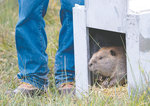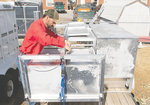Clear, 75° F
With a 90-minute drive in front of him, Jerry Altermatt kept his hands at 10 and 2 on the steering wheel. The furry cargo in the bed of his truck was fragile and represented too many hours of work to …
This item is available in full to subscribers.
The Powell Tribune has expanded its online content. To continue reading, you will need to either log in to your subscriber account, or purchase a subscription.
If you are a current print subscriber, you can set up a free web account by clicking here.
If you already have a web account, but need to reset it, you can do so by clicking here.
If you would like to purchase a subscription click here.
Please log in to continue |
|






With a 90-minute drive in front of him, Jerry Altermatt kept his hands at 10 and 2 on the steering wheel. The furry cargo in the bed of his truck was fragile and represented too many hours of work to count. There was no room for error on this trip.
In back was a 40-pound female beaver, taken from private property where she and her family’s work were flooding a road and farm field. They were needed elsewhere — where flooding would be welcome. This was a special individual. The matriarch for a beaver family of five, her partner and three of her young had already been moved, but she was the first to be released at their new home with a radio transmitter.
Beaver had previously lived on the stream, located in an isolated drainage on the Absaroka front, but mysteriously disappeared about a decade ago. The habitat suffered when the beaver went away.
“It’s not so much about the beaver as it is beaver dams,” Altermatt said.
There are many benefits having beavers doing what they do best. When water is slowed, sediment drops out, increasing the water quality. And when the water level rises, so does the water table surrounding a creek, enabling vegetation to grow. Expanding the wetland area around the creek “is the biggest benefit for terrestrial wildlife,” Altermatt said.
Fish thrive in streams with ponds created by beaver dams and waterfowl are attracted to those areas. In places void of beaver habitat, biologists are forced to do what they can to recreate dams called “beaver dam analogs.” The man-made structures “are intended to make the area more attractive for beavers and increase riparian-dependent, woody vegetation such as willow,” said Travis Cundy, aquatic habitat biologist for the Game and Fish’s Sheridan Region.
Earlier this year, Sheridan Region employees, in partnership with Bighorn National Forest personnel, constructed 10 beaver analogs. The structures are built by installing a line of posts, with a woven lattice of willow branches between them to create a semi-permeable barrier, sealed in some areas with sod and mud to slow the movement of water. Over time, conditions will hopefully attract beaver to naturally populate the area.
Dam analogs have been built in the Cody Region as well — including one recently installed on a stream near Heart Mountain to spur better fishing conditions. But it remains less effective to build a man-made beaver dam than it is to let the pros do the work. That’s why conservationists have been translocating beavers for decades — and why Altermatt found himself recently shuttling one from private Park County property to the Absarokas.
“They’re much smarter than we are,” he said of beavers. “They know where to build the dams where they’ll last and they do it better than we can.”
A ‘jack of all trades’
Altermatt, of Powell, has been a terrestrial habitat biologist for the Game and Fish for the past 27 years, always willing to go the extra mile to improve wild spaces in the Cody Region.
“He possesses a wide variety of knowledge and skills — jack of all trades — that enable him to handle the various components involved in developing and executing wildlife habitat projects,” said Corey Class, wildlife management coordinator with the Game and Fish.
Before he set his first live beaver trap, Altermatt spent weeks in his off time designing and hand-building a specialized
trailer for the dam-building mammals. The trailer is not just a cage on wheels: It’s a beaver habitat, complete with a pond, dining area and removable compartments that, as close as is possible with metal, simulates their natural homes in the wild; Altermatt wanted to avoid as much stress on his targets as possible.
The materials to build the trailer were provided by the Wyoming Outdoorsmen and other “generous donors.” Yet it was up to Altermatt to design, cut, fit and weld the project together. He needed the trailer to be lightweight and strong. Aluminum was the obvious choice. Welding aluminum is a pain, but Altermatt was up to the task.
Only after building the humane means of holding and transporting the rodents did he set live traps. Multiple traps were needed because, Altermatt explained, you can’t just catch one beaver.
“They’re monogamous. They mate for life for the most part,” he said. “They do much better if you move them as a family.”
If a male beaver is caught and relocated before the rest of the family is trapped, he may move on from the new area in search of his mate. And that’s where Altermatt’s beaver trailer comes into play: He can keep the first trapped beaver healthy and relatively happy in the trailer while trying to capture the rest of the family.
“The first beaver is always the easiest to catch. Almost every time I trap I get one the first night; I call it the dumb one,” he said. “The smart one might take a week or two to get.”
Sought by predators and trappers
The female in the back of his Game and Fish truck was the final member to be moved in a family of five. It was also the first beaver Altermatt has equipped with a tail-tag transmitter.
“Before this, after you released them — if they didn’t build a dam and you never saw them again — you didn’t know what happened to them,” he said.
Altermatt isn’t too worried about trappers taking beaver. There was a time when “beaver pelts were like gold,” he said, and the species was nearly hunted to extinction.
“It was certainly enough to drive men out West. Some had no experience trapping and weren’t necessarily even outdoorsmen,” Altermatt said. “But the lure of that money brought them out.”
Hunted for their luxurious fur, beaver pelts could bring an equivalent of $125-200 each in the mid 1800s. Now, however, you can hardly give them away, Altermatt said, with the best skins selling for about $10.
Considering the time of year designated for fur trapping, the time involved in stretching and tanning skins and the prices of equipment and gas, you’re lucky to make a buck. However, that hasn’t stopped some who find trapping to be an enjoyable outdoors activity.
Still, Altermatt is more worried about the beavers moving downstream or being taken by predators. Bears, mountain lions, wolves and coyotes all are threats to the species.
A successful relocation
At the small stream on the Absaroka front where Altermatt dropped off the beaver family, the species was once an important contributor to the habitat.
“I don’t know if they were trapped out, disease took them or if they were preyed on by predators. I just don’t know,” he said. “It has been eight years since I’ve seen any beaver sign. Maybe they could get here on their own over time. I’m just speeding up the process.”
Altermatt doesn’t want the site public in an effort to protect the colony, allowing the beaver’s offspring to prosper. There are only two short windows each year to relocate beavers: early spring and early fall.
Despite their thick fur, if you trap them too early in the year, they can die of hyperthermia. Then beavers are busy caring for young, which won’t survive the late spring and early summer without their parents. By mid-August, kits are old enough to survive on their own and the weather is warm enough for a beaver to survive in a live trap — though it can’t be too hot.
“Beaver are susceptible to overheating,” Altermatt said. “It’s dangerous to handle them when it’s 100 degrees.”
By mid-September, however, it starts getting too cold again.
“You have to give them time to build a lodge and cache food before winter,” Altermatt said.
At the release site on Sept. 27, Game and Fish Information and Education Specialist Tara Hodges accompanied Altermatt to help negotiate the steep banks to a good release point.
As Altermatt opened the gates to freedom, it took a while before the beaver realized her luck. The pretty gal stuck her nose out, then ducked back in. Then slowly she stuck her whole head out, her eyes starting at Altermatt’s feet and moving toward the sky. As much as Altermatt had done to protect her and her colony, no human is to be trusted.
While they’re usually docile creatures, Altermatt has been rushed by an angry beaver before. They’re not quite as ferocious as a charging grizzly — which Altermatt has also experienced — but encounters with any wild animal can be dangerous.
In this case, however, the tagged beaver slowly waddled to the edge of the creek, dived in nose first and disappeared under the edge of the grassy banks.